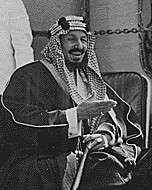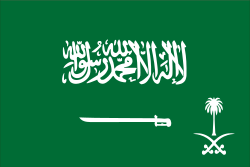Sultan bin Abdulaziz Al Saud
Sultan bin Abdulaziz Al Saud (c. 5 January 1928 – 22 October 2011) (Arabic: سلطان بن عبدالعزيز آل سعود), called Sultan al-Khair (Arabic: سلطان الخير, Sultan the Good) in Saudi Arabia,[1] was a member of the Saudi royal family. A son of King Abdulaziz (Ibn Saud), he was Saudi Defense minister from 1963 to his death in 2011 and the Crown Prince of Saudi Arabia from 2005 to 2011.
| Sultan bin Abdulaziz Al Saud | |||||
|---|---|---|---|---|---|
| Crown Prince of Saudi Arabia | |||||
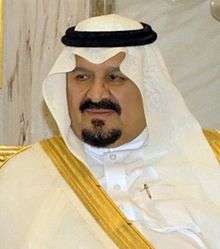 Crown Prince Sultan bin Abdulaziz Al Saud | |||||
| Crown Prince of Saudi Arabia First Deputy Prime Minister | |||||
| Tenure | 1 August 2005 – 22 October 2011 | ||||
| Predecessor | Abdullah | ||||
| Successor | Nayef | ||||
| Monarch | Abdullah | ||||
| Second Deputy Prime Minister | |||||
| Tenure | 13 June 1982 – 1 August 2005 | ||||
| Predecessor | Abdullah | ||||
| Successor | Nayef | ||||
| Monarch | Fahd | ||||
| Minister of Defense and Aviation and Inspector General | |||||
| Tenure | 22 October 1963 – 22 October 2011 | ||||
| Predecessor | Muhammed bin Saud | ||||
| Successor | Salman | ||||
| Monarch | |||||
| Prince of Riyadh Province | |||||
| Tenure | 22 February 1947 – 24 December 1953 | ||||
| Predecessor | Nasser | ||||
| Successor | Nayef | ||||
| Monarch | Abdulaziz Saud | ||||
| Born | c. 5 January 1928 Riyadh, Kingdom of Nejd and Hejaz | ||||
| Died | 22 October 2011 (aged 83) New York City, New York, U.S. | ||||
| Burial | 25 October 2011 Al Oud cemetery, Riyadh | ||||
| Issue | See list
| ||||
| |||||
| House | House of Saud | ||||
| Father | King Abdulaziz | ||||
| Mother | Hassa bint Ahmed Al Sudairi | ||||
| Religion | Hanbali Sunni Islam | ||||
Early life and education
Sultan was born in Riyadh, Najd Sultanate in the mid to late 1920s to early 1930s, with the year being given as 1925, 1928, 1930, and 1931.[2] He was the 15th son of King Abdulaziz[3] and his mother was Hassa bint Ahmed Al Sudairi.[4] He was the second of the Sudairi Seven.[5][6] Prince Sultan, along with many of his brothers, received his early education in religion, modern culture, and diplomacy at the royal court.[7][6]
Early experience
His career in public service began in 1940 when he was made a deputy to then Riyadh governor or emir, Prince Nasser.[6] In 1947, Prince Sultan replaced Prince Nasser as governor of Riyadh.[8][9][10] Prince Sultan also assisted King Abdulaziz's attempts to establish a national administrative system based on the Islamic Sharia law during this period.[8] In 1947, Prince Sultan oversaw ARAMCO's construction of the Kingdom's rail link between Dammam and Riyadh. He was appointed as the kingdom’s first minister of agriculture in 1953[8] and minister of transport in 1955.[11]
Following the assassination of Lebanese prime minister, Riad Al Solh, in 1951 Ibn Saud sent Prince Sultan to Beirut to offer condolences to late prime minister's family.[12]
Although the direct military experience of Prince Sultan was brief, heading the Royal Guard in Riyadh in the early 1950s, he felt a lifelong connection to the military and the cause of Saudi independence from an early age.[13] Major General Carl von Horn, Swedish commander of the UN observer mission during the Yemeni civil war, described the Prince Sultan as "a volatile and emotional young man" in the early days.[13]
Minister of Defense and Aviation
In 1963, Crown Prince Faisal appointed Prince Sultan as minister of defense and aviation.[9][14] He presided over the development of the Saudi armed forces. During the reign of King Faisal, Prince Sultan was particularly interested in Yemen.[15] His influence declined under the reign of King Khalid.[15]
Sultan purchased U.S. tanks, fighter planes, missiles and AWACS (airborne warning and control systems). However, as a result of problems assimilating technology within its armed forces, a relatively high proportion of the military equipment is stored or under maintenance, despite a large portion of Saudi's $34 billion defense budget being spent on maintaining military equipment. Sultan allegedly became extraordinarily wealthy from kickbacks by Western businesses that handled multibillion-dollar defense contracts.[16] He was involved in many scandals, including the Al Yamamah deal.[17] However, his influence remained unhindered until his health began to deteriorate.[17] During his tenure, Saudi Arabia became the largest importer of U.S. arms. He was a strong proponent of U.S.-Saudi partnership.[18]
As well, Sultan authorized a deal with the British Aircraft Corporation (BAC) in 1965. His program, called Operation Magic Carpet, traded £16 million for six second-hand Lightnings, six Hawker Hunters, and a set of missile launchers going to Royal Saudi Air Force. Geoffrey Edwards served as the official intermediary. British pilots also came over, privately contracted.[13] Prince Sultan was an expert on the Yemen civil war and Soviet involvement in the Horn of Africa in 1985.[19]
In 1996, Prince Sultan opposed Pentagon plans to relocate U.S. troops to safer locations after the Dhahran complex bombings.[20] He visited Iran in May 1999 that was the first official visit of a Saudi minister since 1979.[21]
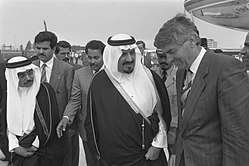
Second Deputy Prime Minister
On 13 June 1982, after the death of King Khalid and Crown Prince Fahd became the King, Prince Sultan was appointed second deputy prime minister.[9][22] Opposition to his appointment as second deputy prime minister came in particular from two half brothers, Musaid and Bandar, both of whom, like Abdullah, were born in 1923 and therefore, were older than Prince Sultan, who was born in 1931. The objection of Prince Musaid was easily ignored since his son, Faisal bin Musaid, had assassinated King Faisal. However, the interests of Bandar bin Abdulaziz were much harder to ignore. Thus, he was compensated and the dispute was resolved.[23]
Prince Sultan, in December 1995, attempted to seize power through the support of the Ulema when Crown Prince Abdullah was in Oman for a summit of the Gulf Cooperation Council.[24] However, his attempted coup failed.[24]
Crown Prince
| Styles of Crown Prince Sultan bin Abdul-Aziz Al Saud | |
|---|---|
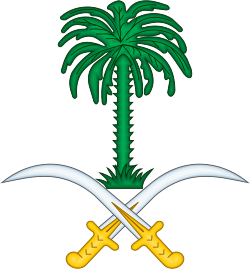 | |
| Reference style | His Royal Highness[25] |
| Spoken style | Your Royal Highness |
On 1 August 2005, Sultan bin Abdulaziz was designated heir apparent despite having a discord with King Abdullah.[26] During the same period he led the group called Sudairi Seven, being the eldest of the group after King Fahd's demise.[27]
Various positions
Prince Sultan was Saudi Arabia's Inspector General. He was chairman of the board of Saudi Arabia's national airline, Saudi Arabian Airlines. As chairman, he approved a ban on smoking inside all Saudi airports.[28] In 1986, he founded the Saudi National Commission for Wildlife Conservation.[29] He was chairman of the Higher Council for Islamic Affairs, which financially supports Muslim communities around the world.[9][30]
Scientific prizes sponsored by Prince Sultan bin Abdulaziz
- Prince Sultan bin Abdulaziz prize for water. He was the founder and patron of the Prince Sultan bin Abdul-Aziz International Prize for Water, a bi-annual international scientific award for water research created in 2002.[31][32]
- Prince Sultan bin Abdulaziz Chair for environmental engineering, department of civil engineering, King Fahd University for Petroleum and Minerals. It is the first chair in the university.
- The scientific agreement between Prince Sultan bin Abdulaziz and Oxford University for academic and cultural co-operation, which enables Saudi students for bachelor, master and PHD degrees in the field of human sciences.[33]
Charity works
A non-profit charity organization, Sultan bin Abdulaziz Al Saud Foundation, was set up and funded by Prince Sultan in 1995 for social objectives. The foundation includes the following centers in different countries:
- Sultan Bin Abdulaziz Humanitarian City[34][35]
- Sultan Bin Abdulaziz Science and Technology Center
- Charity housing projects
- Sultan Bin Abdulaziz Special Education Program at the Arabian Gulf University in Bahrain
- Prince Sultan Center for Speech and Hearing in Bahrain
- King Abdulaziz Center for Islamic Studies at Bologna University
- Sultan Bin Abdulaziz Arab and Islamic Studies Program at the University of California, Berkeley
- Prince Sultan Bin Abdulaziz Private: Committee for Relief.
This private committee organizes relief and medical convoys and sets up camps to combat diseases like Malaria and blindness. It has carried out several developmental, social and medical projects, like, digging wells, building schools, public libraries, mosques, hospitals, establishing dialysis centers. It also sponsors Muslim preachers in Ethiopia, Chad, Niger, Malawi, Mali, Comoro Islands, Djibouti and Indonesia.[33]
He inaugurated and served as the patron of Prince Sultan University in Riyadh. It was named in his honor by the university's parent institution, Al-Riyadh Philanthropic Society, which was founded by the prince's brother, Salman of Saudi Arabia, who would later become king. This is the first private/non-profit university established in the kingdom.
Controversy
In 2002, families of the victims of the September 11 attacks in the United States sued Prince Sultan and other senior Saudi officials for their alleged contributions to al-Qaeda linked charities.[36] The lawsuits were thrown out by a US federal judge due to insufficient evidence submitted.[36]
Donations
In April 2005, Sultan donated £2 million to the Ashmolean Museum. This is regarded as one of the most controversial donations Oxford University received. A year after his donations to establish an art museum, Oxford University agreed to 'expedite' the scholarship application process for Saudi students, and identify colleges for ten Saudi students from Prince Sultan University (PSU). When this arrangement became public, it led to criticism from both academics and students stating that it was no academic worth to the university, bypassing Oxford’s governing council, and breaching the admissions process for prospective students.[37]
A press release issued by Oxford University on 20 April 2005 said that:
HRH Prince Sultan bin Abdulaziz Al Saud has given the Ashmolean Museum a substantial donation to provide a fitting home for the Museum's internationally renowned collection of Islamic art. The total value of the gift is £2 million, which will also provide for ten scholarships at the University of Oxford for Saudi Arabian students.
The press release added further that ‘the new gallery, part of the ambitious redevelopment of one of the world’s oldest museums, will be named the “Prince Sultan bin Abdulaziz al Saud Gallery”’. Arab News on 21 April 2005 reported that Sultan’s donation was a ‘move to promote understanding between Islam and the West’, adding that ‘Saudi and British officials’ had said that the new gallery ‘will help to portray Islamic culture and civilization in right perspectives.’[37]
Personal life
Prince Sultan had thirty-two children by his multiple wives. His eldest son Khalid bin Sultan, after Prince Sultan's death, was appointed deputy minister of defense and served in the post until 20 April 2013.[38] Bandar bin Sultan was the former ambassador to the USA. He was also the secretary general of the national security council between 2005 and January 2015, and the former head of the general intelligency directorate. Fahd bin Sultan is the governor of the Tabuk province. Salman bin Sultan, another son, is the former deputy defense minister.[39] Faisal bin Sultan (born 1951) is the secretary general of Sultan bin Abdulaziz Al Saud Foundation.[40][41]
His other sons are Turki (1959–2012), Nayef (born 1979), Badr (born 1980), Saud, Ahmad (born 1983), Nawwaf, Abdullah, Mishaal (born 1988), Mansour, Fawwaz, Abdulmajid and Abdul Ilah.[41]
Prince Sultan had fifteen daughters, the oldest of whom is Nawf bint Sultan.[42] One of his daughters, Reema, is married to Muhammad bin Nayef, son of the late Crown Prince Nayef bin Abdulaziz.[43] His other daughter, Noura bint Sultan, is married to Turki bin Nasser. Another daughter, Munira bint Sultan, who was late Faisal bin Fahd's spouse and died in June 2011 at age 59.[44][45]
Wives
- Munira bint Abdulaziz bin Musaed bin Jalawi (deceased), mother of Khalid, Fahd, Faisal and Turki[46]
- Huda bint Abdullah Al Shaikh, mother of Saud, Nayef, Nawwaf, Badr, Abdullah and Mansour
- Areej bint Salem Al Maree, mother of his youngest two sons, Abdulmajid and Abdul Ilah
- Hussa bint Muhammed bin Abdulaziz bin Turki (divorced), mother of Princess Daad [41]
- Tarfah bint Abdullah bin Abdulrahman Aldakhil
- Jowaher bint Mohammed bin Saud bin Nasser Al Farhan Al Saud (divorced)
- Mouda bint Saud Al Kabeer Al Saud (divorced)
- Mounira bint Mishaal bin Saud Al Rashid (deceased)
- Leila Al Thunayan (sister of Iffat Al Thunayan) (divorced)[47]
- Mouda bint Salman Al Mandeel Al Khaldi (divorced)
- Dina bint Abdulhamid Alsahhaf (divorced)
- Maha bint Abdullah Al Binyan (divorced)
- Abir bint Fahd Al Faisal Al Farhan Al Saud (divorced), mother of Fawwaz
- Ghadir bint Shawaan Al Shibani (divorced)
- Mashail bint Mamdouh Al Ali[48]
Characteristics
Prince Sultan was regarded as a workaholic .He doled out money at banquets in keeping with tribal custom. A conservative, it was expected that he would have put a brake on Abdullah's timid reforms, if he had become king, he was considered to be pro-American.[49]
Views
Sultan took a lifetime anti-communist and anti-Soviet view, based on his dislike of Soviet state atheism as well as Soviet interest in Gulf oil and access to ports that he felt risked Saudi independence. He rebuked U.S. President Jimmy Carter for what he saw as "pusillanimity" in the face of the Soviet invasion of Afghanistan.[13]
In a 23 October 2001 interview in Kuwaiti newspaper As Seyassa, concerning 9/11 attacks, Sultan stated “Who stands behind this terrorism and who carried out this complicated and carefully planned terrorist operation? Osama bin Laden and those with him have said what indicates that they stand behind this carefully planned act. We, in turn, ask: Are bin Laden and his supporters the only ones behind what happened or is there another power with advanced technical expertise that acted with them?”.[50]
Wealth and property
Prince Sultan’s wealth in 1990 was reported to be $1.2 billion.[51] Later, his fortune was estimated at $270 billion, which he distributed between his sons prior to his death in October 2011 in order to support their political position in the competitive princely arena.[52][53] Prince Sultan owned 2–8a Rutland Gate, the former London residence of the Lebanese politician and businessman Rafic Hariri. Prince Sultan had been given the property after Hariri's assassination in 2005.[54]
Documents in the Paradise Papers release show Prince Sultan used the law firm Appleby at the center of the use of offshore businesses and trusts by world leaders.[55]
Health issues
Prince Sultan was rumored to have had colon cancer in 2003. A foreign correspondent was forced to leave the country after reporting his health problems.[56]
In 2004, Prince Sultan was diagnosed with colon cancer and underwent several corrective surgeries. He underwent an operation to remove an intestinal polyp in Jeddah in 2005.[8][57] Prince Sultan visited a Swiss clinic in late April 2008.[57] In April 2009, he began to suffer from Alzheimer's disease.[58][59]
A leaked March 2009 diplomatic cable from WikiLeaks stated that U.S. diplomats viewed Prince Sultan as "for all intents and purposes incapacitated".[60] He was possibly suffering dementia, specifically Alzheimer's disease.[61]
Morocco vacation
In February 2009, Sultan spent several months in New York City at New York–Presbyterian Hospital and underwent surgery in New York. He then convalesced at Agadir, Morocco. He went back to Saudi Arabia, but soon returned to Morocco in August 2009. During his vacation, the Saudi cabinet increased officer salaries, a traditional domain of Sultan.[62]
In 2009, King Abdullah took charge of all defense purchases and reduced the power of the Defense Ministry. In October 2010, Abdullah personally conducted much of the negotiations for the U.S. arms package worth over $60 billion.[63]
In November 2010, Sultan received in Agadir Lebanese Prime Minister Saad Al-Hariri to discuss the future of Lebanon's government.[64] He had been receiving treatment since 2009 for what analysts and diplomats believed to be cancer.[65] At the end of November 2010, he returned to Saudi Arabia because King Abdullah had left for the United States for surgery. His return was seen as a legal formality necessary under Saudi law, which stipulates that only one of the kingdom's top two officials can be abroad at a given time.[66]
Death and funeral
The Saudi Royal court announced on 22 October 2011 that Prince Sultan died at dawn of an unspecified illness.[67][68] According to media reports, Prince Sultan had been battling cancer and had been seeking medical treatment in the United States since mid-June 2011.[69][70] He had a surgical operation in New York in July 2011.[71] Unnamed U.S. officials cited by The New York Times stated that he died at New York-Presbyterian Hospital in Manhattan.[72]
His body was taken from New York City to Riyadh on 24 October 2011.[71] His funeral was held at the Imam Turki bin Abdullah mosque in Riyadh on 25 October 2011 in the presence of King Abdullah bin Abdulaziz.[69] He was buried in Al Oud cemetery in Riyadh.[73]
Various leaders, including the president of Afghanistan, Farouk Al Sharaa, the then vice-president of Syria, the Iranian foreign minister and the head of Egypt's ruling military council, participated in the funeral.[71] Additionally, other statesmen went to Riyadh to offer their condolences, such as the US Vice President Joe Biden, Pakistani President Asif Ali Zardari and Malaysian Prime Minister Najib Razak.[74]
Honours
Among others, Prince Sultan was the recipient of the following honours and medals:








He was also posthumously given the King Khalid award in 2011.[76]
Ancestry
| Ancestors of Sultan bin Abdulaziz Al Saud | |||||||||||||||||||||||||||||||||||||||||||||||||||||||||||||||||||||||||||||||||||||||||||||||||||||||||||||||||||||||||||||||||||||||||||||||||||||||||||||||||||||||||||||||||||||||||||||||||||||||||||||||||||||||||||||||||||||||||||||||||||||||||||||||||||||||||||||||||||||||||||||||||||||||||||||||||||||||||||||||||||||||||||||||||||||||||||||||||||||||||||||||||||||||||||||||||||||||||||||||||||||||||||||||||||||||||||||||||||||||||||||||||||||||||||||||||||||||||||||||||||||||||||||||||||||||||||||||||||||||||||||||||||||||||||||
|---|---|---|---|---|---|---|---|---|---|---|---|---|---|---|---|---|---|---|---|---|---|---|---|---|---|---|---|---|---|---|---|---|---|---|---|---|---|---|---|---|---|---|---|---|---|---|---|---|---|---|---|---|---|---|---|---|---|---|---|---|---|---|---|---|---|---|---|---|---|---|---|---|---|---|---|---|---|---|---|---|---|---|---|---|---|---|---|---|---|---|---|---|---|---|---|---|---|---|---|---|---|---|---|---|---|---|---|---|---|---|---|---|---|---|---|---|---|---|---|---|---|---|---|---|---|---|---|---|---|---|---|---|---|---|---|---|---|---|---|---|---|---|---|---|---|---|---|---|---|---|---|---|---|---|---|---|---|---|---|---|---|---|---|---|---|---|---|---|---|---|---|---|---|---|---|---|---|---|---|---|---|---|---|---|---|---|---|---|---|---|---|---|---|---|---|---|---|---|---|---|---|---|---|---|---|---|---|---|---|---|---|---|---|---|---|---|---|---|---|---|---|---|---|---|---|---|---|---|---|---|---|---|---|---|---|---|---|---|---|---|---|---|---|---|---|---|---|---|---|---|---|---|---|---|---|---|---|---|---|---|---|---|---|---|---|---|---|---|---|---|---|---|---|---|---|---|---|---|---|---|---|---|---|---|---|---|---|---|---|---|---|---|---|---|---|---|---|---|---|---|---|---|---|---|---|---|---|---|---|---|---|---|---|---|---|---|---|---|---|---|---|---|---|---|---|---|---|---|---|---|---|---|---|---|---|---|---|---|---|---|---|---|---|---|---|---|---|---|---|---|---|---|---|---|---|---|---|---|---|---|---|---|---|---|---|---|---|---|---|---|---|---|---|---|---|---|---|---|---|---|---|---|---|---|---|---|---|---|---|---|---|---|---|---|---|---|---|---|---|---|---|---|---|---|---|---|---|---|---|---|---|---|---|---|---|---|---|---|---|---|---|---|---|---|---|---|---|---|---|---|---|---|---|---|---|---|---|---|---|---|---|---|---|---|---|---|---|---|---|---|---|---|---|---|---|---|---|---|---|---|---|---|---|---|---|---|---|---|---|---|---|---|---|---|---|---|---|---|---|---|---|---|---|---|---|---|---|---|---|---|---|---|---|---|---|---|---|---|---|---|---|---|---|---|---|---|---|---|---|---|---|---|---|---|---|---|---|---|---|---|---|---|---|---|---|---|---|---|---|---|---|---|---|---|---|---|---|---|---|---|---|
| |||||||||||||||||||||||||||||||||||||||||||||||||||||||||||||||||||||||||||||||||||||||||||||||||||||||||||||||||||||||||||||||||||||||||||||||||||||||||||||||||||||||||||||||||||||||||||||||||||||||||||||||||||||||||||||||||||||||||||||||||||||||||||||||||||||||||||||||||||||||||||||||||||||||||||||||||||||||||||||||||||||||||||||||||||||||||||||||||||||||||||||||||||||||||||||||||||||||||||||||||||||||||||||||||||||||||||||||||||||||||||||||||||||||||||||||||||||||||||||||||||||||||||||||||||||||||||||||||||||||||||||||||||||||||||||
References
- "The Dream of Gerontocracy". The Weekly Middle East Reporter. 29 October 2011. Retrieved 28 March 2013.
- "وفاة ولي العهد السعودي الأمير سلطان بن عبد العزيز عن عمر يناهز 80 عاماً" [Saudi Crown Prince, Sultan bin Abdulaziz dies at 80]. www.alarabiya.net (in Arabic). Retrieved 20 October 2017.
- Mouline, Nabil (April–June 2012). "Power and generational transition in Saudi Arabia" (PDF). Critique internationale. 46: 1–22. Retrieved 24 April 2012.
- Winberg Chai (22 September 2005). Saudi Arabia: A Modern Reader. University Press. p. 193. ISBN 978-0-88093-859-4. Retrieved 26 February 2013.
- Shenk, Mark (1 August 2005). "Oil Surges to Record as King Fahd's Death Raises Supply Concern". Bloomberg. Retrieved 4 March 2013.
- "The Political Leadership - King Fahd". APS Review Gas Market Trends. 29 November 1999. Retrieved 16 March 2013.
- Sultan bin Salman Al Saud (March 2001). "Supporting Peace, Justice and Equality". Presidents and Prime Ministers. 10 (2): 16. Retrieved 31 August 2013. – via Questia (subscription required)
- "Saudi heir to throne dies in hospital". CBC. AP. 22 October 2011. Retrieved 29 July 2012.
- "Profile: Saudi Prince Sultan". BBC. 1 August 2005. Retrieved 1 February 2013.
- George Kheirallah (1952). Arabia Reborn. Albuquerque: University of New Mexico Press. p. 254. Retrieved 14 March 2015. – via Questia (subscription required)
- Glen Carey; Vivian Salama (1 November 2011). "Crown Prince Sultan's Death Starts Plan for Saudi Succession". Bloomberg Businessweek. Retrieved 13 April 2012.
- "Trinkets from Tola!". Time Magazine. 64 (12). 20 September 1954. Retrieved 8 August 2020.
- "Crown Prince Sultan Ibn Abdul-Aziz al Saud". The Daily Telegraph. London. 23 October 2011. Retrieved 25 October 2011.
- "Veteran Saudi defence minister becomes heir to throne". Lebanonwire. Riyadh. 1 August 2005. Archived from the original on 23 March 2013. Retrieved 1 February 2013.
- P. Edward Haley; Lewis W. Snider; M. Graeme Bannerman (1979). Lebanon in Crisis: Participants and Issues. Syracuse University Press. p. 9. ISBN 978-0-8156-2210-9. Retrieved 16 October 2012.
- "The way we live now". The New York Times. 22 December 2002. Retrieved 9 December 2010.
- "Saudi king to US for treatment of back ailment". Yahoo! News. 21 November 2010. Retrieved 9 December 2010.
- Nawaf Obaid (12 August 2002). "Backlash in Saudi Arabia". The Christian Science Monitor. Retrieved 9 December 2010.
- "Briefing for the Prime Minister's meeting with Prince Sultan" (PDF). The Guardian. London. 25 September 1985. Archived (PDF) from the original on 16 May 2011. Retrieved 9 December 2010.
- "Saudi Arabia – Defense Minister opposes U.S. plans to move soldiers". The Vindicator. 15 July 1996. Retrieved 9 December 2010.
- Anthony H. Cordesman (1 April 2003). Saudi Arabia Enters the Twenty-First Century: The Political, Foreign Policy, Economic, and Energy Dimensions. Greenwood Publishing Group. p. 5. ISBN 978-0-275-97998-0. Retrieved 29 September 2012.
- "Crown Prince Fahd takes control of largest oil-exporting nation". Herald Journal. 14 June 1982. Retrieved 28 July 2012.
- Simon Henderson (August 2009). "After King Abdullah. Succession in Saudi Arabia" (PDF). Policy Focus. 96.
- Paul Michael Wihbey (July 1997). "Succession in Saudi Arabia: The not so Silent Struggle". IASPS Research Papers in Strategy (4).
- "Council of Ministers: Membership". Royal Embassy of Saudi Arabia, Washington, DC. Archived from the original on 16 June 2011. Retrieved 10 June 2011.
- Leyne, Jon. Tensions remain among Saudi royals, BBC News, 1 August 2005. Retrieved 7 December 2008.
- William Safire (12 September 2002). "The Split in the Saudi Royal Family". The New York Times. Retrieved 13 April 2013.
- Fatima Sidiya (19 October 2010). "Kingdom bans smoking at airports". Arab News. Archived from the original on 20 October 2010. Retrieved 9 December 2010.
- Butt, Gerald (3 June 2004). "Profile: Saudi Prince Sultan". BBC. Retrieved 9 December 2010.
- "Who's who: Senior Saudis". BBC. 30 October 2007. Retrieved 27 April 2012.
- "About the Prize". PSIPW. Archived from the original on 27 February 2009. Retrieved 31 December 2008.
- "HRH Prince Sultan: Environmentalist and Art Patron". Oasis Magazine. Winter 2009–2010. Archived from the original on 19 May 2014. Retrieved 19 July 2013.
- "Biography. Prince Sultan bin Abdulaziz bin Abdulrahman bin Faisal Al Saud". iTTaleem. Retrieved 31 March 2012.
- "Sultan bin Abdulaziz Humatarian City". Sultan bin Abdulaziz Humatarian City. Retrieved 31 March 2012.
- "Sultan bin Abdulaziz Humanitarian City (SBAHC)". Euro Synapses. Archived from the original on 28 September 2012. Retrieved 29 August 2012.
- "Veteran Saudi defence minister becomes heir to throne". Lebanonwire. Riyadh. AFP. 1 August 2005. Archived from the original on 23 March 2013. Retrieved 12 April 2013.
- Simcox, Robin (2009). "A Degree of Influence" (PDF). The Centre for Social Cohesion. Retrieved 22 April 2012.
- "Saudi deputy defence minister Prince Khalid Bin Sultan replaced". Gulf News. Reuters. 20 April 2013. Archived from the original on 24 April 2013. Retrieved 20 April 2013.
- "Son of former Saudi crown prince named deputy defence minister". Reuters. 6 August 2013. Retrieved 7 August 2013.
- "Sultan bin Abdulaziz al Saud Foundation sponsors Arab Creativity Award Ceremony". AMEINFO. Archived from the original on 29 July 2013. Retrieved 31 March 2012.
- Sabri Sharif (2001). The House of Saud in Commerce: A Study of Royal Entrepreneurship in Saudi Arabia,. New Delhi: I. S. Publication. ISBN 81-901254-0-0.
- Abdullah Al Oreifij (12 December 2009). "'He is a father to every Saudi'". Saudi Gazette. Riyadh. Archived from the original on 29 July 2013. Retrieved 29 December 2012.
- "Time, surely, for a much younger one". The Economist. 29 October 2011. Retrieved 26 April 2012.
- "Rulers offer condolences to Prince Sultan bin Abdulaziz". WAM Emirates News Agency. 11 June 2011. Archived from the original on 19 May 2014. Retrieved 6 May 2012.
- "Prince Sattam performs funerary prayers over the deceased". Ain Alyaqeen. 17 June 2011. Retrieved 12 February 2013.
- "Wife of Saudi crown prince dies in Paris hospital". The Daily Star Lebanon. 25 August 2011. Retrieved 5 April 2012.
- As'ad AbuKhalil (2004). The Battle for Saudi Arabia. Royalty, fundamntalizm and global power. New York City: Seven Stories Press. ISBN 1-58322-610-9.
- "Saudi King, Crown Prince Receive al-Faghm Family Members". Sada Elbalad English. 30 September 2019. Retrieved 25 May 2020.
- Penketh, Anne (17 June 2008). "Succession at House of Saud: The men who would be king". The Independent. Retrieved 13 April 2012.
- Dudney, Robert S. (December 2001). "Verbatim Special: War on Terror" (PDF). Air Force Magazine: 40–48. Retrieved 22 April 2012.
- "The billionaires 1990". CNN/Fortune. 10 September 1990. Archived from the original on 17 January 2013. Retrieved 15 August 2012.
- Yamani, Mai (25 October 2011). "Saudi Arabia's Old Regime Grows Older". Project Syndicate. Retrieved 23 April 2012.
- Riedel, Bruce (1 November 2011). "What to Expect from the New Saudi Crown Prince". National Interest. Retrieved 23 April 2012.
- Ed Hammond and Sally Gainsbury (12 September 2012). "Hyde Park mansion on sale for £300 million". The Financial Times. Retrieved 28 October 2015.
- "Prince Khaled bin Sultan bin Abdulaziz Al Saud". Offshore Leaks Database. ICIJ.
- Henderson, Simon (11 December 2009). "Saudi Royals Reunited? Crown Prince Sultan Returns Home". The Washington Institute. Retrieved 9 December 2010.
- Hammond, Andrew (7 May 2008). "Saudi prince health signals possible power clash". Middle East Online. Riyadh. Archived from the original on 19 May 2014. Retrieved 11 February 2013.
- "Crown Prince Sultan Suffers from Alzheimers". Arabia Today. 1 February 2011. Retrieved 18 October 2011.
- "The royal house is rattled too". The Economist. 3 March 2011. Retrieved 18 October 2011.
- Fraker (31 March 2009). "Scenesetter for Senator Bond's April 6–8 visit to Saudi Arabia". WikiLeaks. WikiLeaks cable: 09RIYADH496. Archived from the original on 31 December 2010. Retrieved 11 January 2011. Cite journal requires
|journal=(help) - Henderson, Simon (7 January 2011). "Saudi Arabia's Oil Policy Vacancies". The Washington Institute. Retrieved 27 May 2012.
- "Saudi crown prince in good health, on holiday". Khaleej Times. Reuters. 27 October 2010. Retrieved 9 December 2010.
- "For Saudis, U.S. Arms Deal is a Challenge". iWireNews ™ (iWireNews ™ and OfficialWire). 26 October 2010. Retrieved 9 December 2010.
- "Sultan receives Hariri in Agadir". Arab News. 4 November 2010. Archived from the original on 7 December 2010. Retrieved 9 December 2010.
- "Saudi king to US for treatment of back ailment". Yahoo! News. 21 November 2010. Retrieved 9 December 2010.
- Summer Said and Margaret Coker (22 November 2010). "Saudi King to Seek Medical Care in U.S." The Wall Street Journal. Retrieved 9 December 2010.
- "Prince Sultan bin Abdel Aziz of Saudi Arabia Dies". The New York Times. New York. ISSN 0362-4331. Retrieved 29 August 2012.
- "Saudi Arabia's Crown Prince Sultan bin Abdulaziz Al Saud Dies". Fox News. Retrieved 26 June 2012.
- McDowall, Angus (22 October 2011). "Saudi Crown Prince dies: royal court". Reuters. Retrieved 22 October 2011.
- "Saudi Arabian Crown Prince Sultan dies". BBC. 22 October 2011. Retrieved 22 October 2011.
- "Funeral held for Crown Prince Sultan". BBC. 25 October 2011. Retrieved 29 July 2012.
- MacFarquhar, Neil (22 October 2011). "Prince Sultan bin Abdulaziz of Saudi Arabia Dies". The New York Times. Retrieved 24 October 2011.
- Shaheen, Abdul Nabi (23 October 2011). "Sultan will have simple burial at Al Oud cemetery". Gulf News. Retrieved 29 July 2012.
- "Saudi Arabia holds funeral of Crown Prince Sultan". Al Arabiya. 25 October 2011. Retrieved 29 July 2012.
- Quirinale website
- "Head of King Khalid Award announces names of winners". Ain Alyaqeen. 25 November 2011. Retrieved 20 July 2013.
- "Semakan Penerima Darjah Kebesaran, Bintang dan Pingat".
- "Semakan Penerima Darjah Kebesaran, Bintang dan Pingat Persekutuan".
External links
| Wikimedia Commons has media related to Sultan bin Abdul Aziz Al Saud. |
| Saudi Arabian royalty | ||
|---|---|---|
| Preceded by Abdullah |
Crown Prince of Saudi Arabia 1 August 2005 – 22 October 2011 |
Succeeded by Nayef |
| Political offices | ||
| Preceded by Nasser bin Abdulaziz Al Saud |
Governor of Riyadh 1947–1952 |
Succeeded by Nayef bin Abdulaziz Al Saud |
| Preceded by Abdullah bin Abdulaziz Al Saud |
Second Deputy Prime Minister of Saudi Arabia 1982 – 27 March 2009 |
Succeeded by Nayef bin Abdulaziz Al Saud |
| Preceded by Abdullah bin Abdulaziz Al Saud |
First Deputy Prime Minister of Saudi Arabia 1 August 2005 – 22 October 2011 |
Succeeded by Nayef bin Abdulaziz Al Saud |
